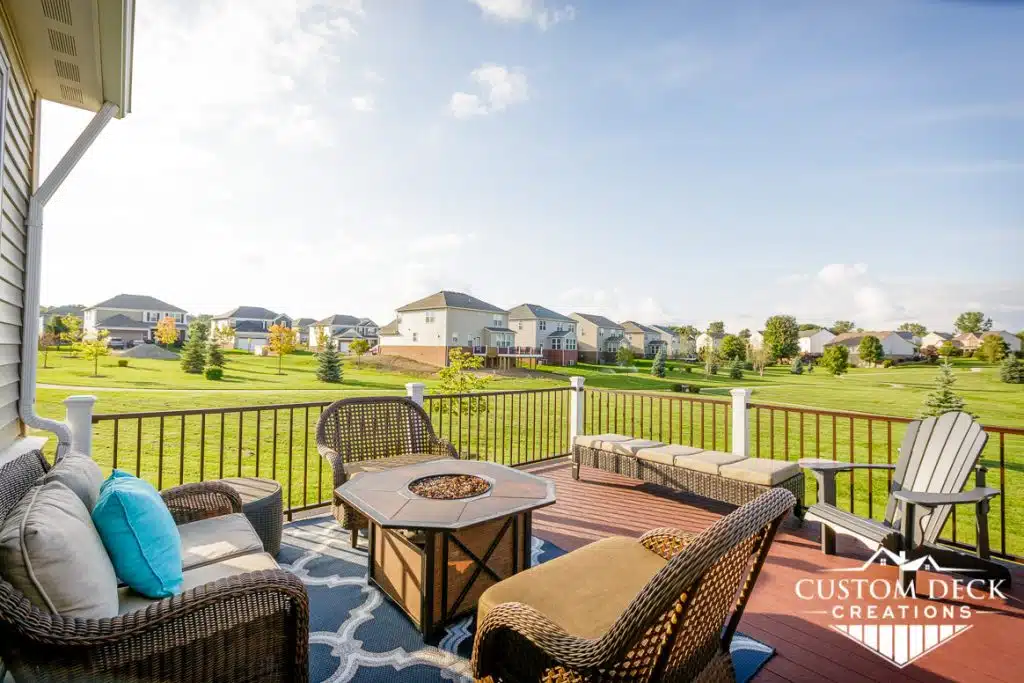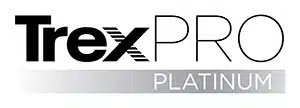Does composite decking get hot enough to burn your feet and send you running back to the safety of your house? And will it get even hotter than a wood deck or a patio?
We totally understand your concern. After all, you’re going to be spending a lot of the time on your deck during those long summer days. It’s nice to know if you can wear light socks or go barefoot without burning your feet.
So today, we’re going to answer these questions and give you our best tips for keeping your deck cool when it starts to get hot outside.
How Hot Does Composite Decking Get?
The two main factors that determine how hot composite decking will get are if it’s in direct sunlight and the color of the boards. So we did our research and found various tests comparing the temperature differences between Trex colors, a few types of wood, and patio materials for comparison.
Test #1: Trex & PT Lumber in 80° F
In this first test, five colors of Trex and two PT (pressure treated) lumber boards were left to bake in the sun for a few hours at 80°F. Here are the results:
Trex
Rocky Harbor (light brown): 93°F
Toasted Sand (medium brown): 98°F
Vintage Lantern (dark brown): 101°F
Coastal Bluff (dark brown): 96°F
Island Mist (medium grey): 95°F
Pebble Grey (medium grey): 95°F
PT Lumber
Unstained: 81°F
Dark Stain: 91°F
Note: One thing to point out, these boards were all on the ground in the cool grass. So their temperatures may be different than if they were up on your deck (which has more air ventilation/movement around the boards).
Watch the full video: Does Composite Decking Give Out More Heat?
Test #2: Composite & Painted Wood in 86° F
The second test compares multiple decking materials, but our focus is on a light brown composite board and a painted wood board of a very similar color:
Painted Wood: 108°F
Composite: 111°F
Watch the video and see all the results: Decking Heat Test Comparison.
Test #3: Trex, Stained Wood & Flagstone Pavers in 86° F
For the third test, Trex, IPE hardwood, treated yellow pine, and pavers were left out all day at 86°F. The conditions were mostly full sun, with only thin clouds at times. Here’s how hot each material got:
Trex
Tiki Torch (light brown): 135°F
Havana Gold (light-medium brown): 137°F
Island Mist (medium grey): 135°F
Spiced Rum(dark brown): 148°F
Lava Rock(dark reddish-brown): 147°F
Stained IPE Hardwoods
All Colors Ranged: 136°F – 137°F
Stained Treated Yellow Pine
Clear: 119°F
Cedartone: 122°F
Redwood: 125°F
Gold: 128°F
California Cedar: 130°F
Russet Brown: 132°F
Butternut Brown: 133°F
Slate Gray: 121°F
Paver Stones
All Flagstone Pavers Ranged: 119°F to 126°F
Now that we’ve seen how hot composite decking and wood can get, what about concrete and pavers?
Test #4: Various Patio Pavers in 90°F
All pavers will soak up the heat from the sun, but some stay at a more reasonable temperature than others. As a close comparison to the two tests above, here’s how hot these pavers can get when the outside temperature is 90°F:
Concrete: 119°F
Flagstone: 112°F
Travertine: 108°F
Shell Stone: 94°F
Note: Concrete pavers tend to be cooler than solid poured concrete. In the direct sunlight on a hot summer day, poured concrete can easily get to 135°F. And in some warmer states like Arizona or Nevada, it can even reach 175°F.
Brick & Clay
Any paver made from brick, clay, or other ceramics will absorb and retain heat more than the previous materials mentioned. On a sunny day at an outside temperature of 100°F, light pavers can reach upwards of 150°F, and dark pavers can get even hotter.
Read more: How Hot Do Pavers Get Around Pool Decks?
Results: Will Composite Get Hotter Than Wood or a Patio?
Composite Vs. Wood
The results are in, and looking at these tests, wood that hasn’t been stained or has a very light stain will be cooler on a hot day. But the temperature may also vary depending on the density of the wood itself.
But the difference between stained or painted wood (which you see most commonly for wood decks) and composite decking of similar color is less dramatic. Wood still ends up being slightly cooler on average, but your color consideration is what will make the most significant impact. These differences will seem imperceptible without an IR thermometer like these tests used.
Composite Vs. Patio Pavers & Concrete
Brick, clay, and poured concrete take the lead as the hottest out of all the materials we’ve covered today. And they easily surpass the top temperatures of composite decking.
Whereas flagstone, travertine and shell stone will be closer to the same temperature as wood or composite. But can get hotter or cooler depending on the situation.
PRO TIP: Test Your Own Samples
It’s good to keep in mind the results of every test will vary, and the location and amount of time left in the sun will significantly impact the how hot composite decking will get.
Get some sample boards of the colors or materials you’re considering. Leave them outside your home on a hot sunny day, then step on them with your socks on or bare feet, whatever you’ll most often do in your outdoor space. Then cover the samples with an umbrella, and repeat the test.
Doing this will give you the most accurate test for how hot your deck will get where you live.
Other Commonly Asked Questions
Will Composite Decking Get Too Hot to Walk On?
Older generations (installed prior to 2009) of composite decking will get hot quickly and become uncomfortable for most people to walk. But composite decking material has come a long way in recent years and is much less sensitive to heat. However, even modern composite decking will get too hot to walk on without socks or shoes under the right circumstances. So will any decking (wood included), for that matter.
So the real question is how quickly it gets to that point. After talking with many homeowners (some shoe-wearers, barefooters, or sock wearers), it really depends on the person and the weather (direct sunlight, cloudy, etc.)
But generally, it’s safe to assume that you shouldn’t have a problem if you’re wearing shoes or socks. If you’re going barefoot, many people reach their limits between 110°F and 115°F. But we’d recommend being extra cautious with small children or if you have sensitive feet.
Heat Transfer
A little fun fact worth knowing is that heat transfers quicker between your feet and composite than your feet and wood.
So what that means is the first step you take on composite decking will feel much hotter. But as you continue to stand in one spot, your feet absorb the heat, and the deck surface will start to cool.
The opposite happens with wood. When you’re standing on a wooden deck on a hot day, the longer you stay in one spot, the hotter the deck starts to feel under your feet.
Is Composite Safe for Dogs Paws?
It’s not only our feet that we should consider, but we should also be thinking about our dog’s paws. In general, surfaces over 120°F will be very uncomfortable, and 130°F and up can cause burns, permanent damage, and scarring.
It’s always best to be safe and check how hot your deck is before letting your dog walk on it. Try placing the back of your hand against the surface for at least 7 seconds. If it gets too hot for your hand, then it’s also too hot for your pup’s paws.
PRO TIP: Dog Blanket or Bed
Put a blanket or bed on your deck to give your dog a place to go if their paws get too hot, but they want to stay outside with you.
How to Keep Composite Decking From Getting Too Hot
For the peak summer months when the sun is at its hottest, you have plenty of options to keep your deck cool.
Choose a Lighter Shade of Color
Trex and other composite decking manufacturers offer a wide selection of shades and colors. Go for a lighter grey or brown if you’re concerned that your deck will get too hot; they won’t retain heat as much as darker colors.
Install a Pergola
Install a wood, vinyl, fiberglass or aluminum pergola over all or part of your deck. The lattice roof will provide a bit of shelter, or you can also use it to hang a shade cloth or a climbing vine.
Use Awnings & Umbrellas
Retractable umbrellas have the advantage of mobility; you can quickly and easily move them around your deck as needed. Many outdoor table units also come with umbrellas, or you can buy them freestanding.
Awnings are more permanent and attach to the side of your house. They can be fixed or retractable, but we usually recommend the latter as they’re better suited to the weather here in Michigan.
Build Your Deck Where it Gets Mid Day Shade
If you’re still in the planning stages, consider if where you’re building your deck will get mid-day shade from trees or buildings (or simply plant a beautiful new tree!).
We understand that there may only be one or two places where you can build your deck in many situations. But it’s worth keeping an open mind and exploring all your options.
Conclusion
Composite decks can get hot. But so do wood decks or any other patio material. The bottom line is any decking will likely get too hot to walk on barefoot if it’s in the scorching summer sun all day.
Although lightly-stained wood decking and some pavers may be slightly cooler than composite, the real culprit that causes your deck to heat up is the color you choose. And with all the advantages of composite over other decking materials, we’ll take the slight heat difference any day.
What Next?
Are you planning on building a new deck? We’d love to hear from you!
At Custom Deck Creations, we build composite decks for clients across Southeast Michigan. We work with you to design and build a deck to match your vision and budget, including choosing the perfect color to help keep your deck cool in those hot summer months. Feel free to give us a call and check out some of our most recent builds.
If you’ve enjoyed this article, share it with a friend who would find it helpful. Want to keep reading? Check out these posts next:









